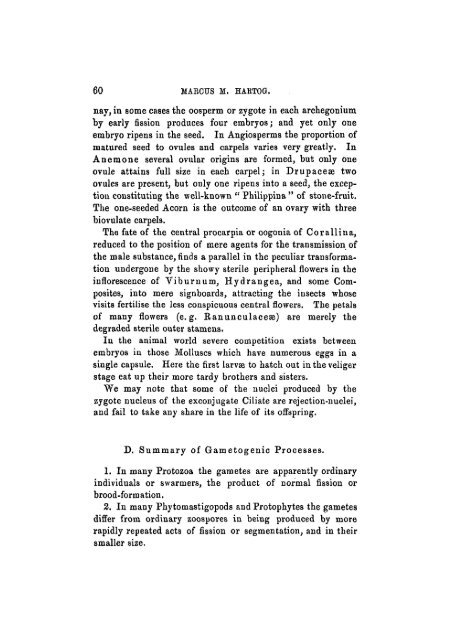Some Problems of Reproduction: a Comparative Study of ...
Some Problems of Reproduction: a Comparative Study of ...
Some Problems of Reproduction: a Comparative Study of ...
Create successful ePaper yourself
Turn your PDF publications into a flip-book with our unique Google optimized e-Paper software.
60 . MABCTJS M. HABTOG.<br />
nay, in some cases the oosperm or zygote in each archegonium<br />
by early fission produces four embryos; and yet only one<br />
embryo ripens in the seed. In Angiosperms the proportion <strong>of</strong><br />
matured seed to ovules and carpels varies very greatly. In<br />
Anemone several ovular origins are formed, but only one<br />
ovule attains full size in each carpel; in Drupacese two<br />
ovules are present, but only one ripens into a seed, the exception<br />
constituting the well-known " Philippina " <strong>of</strong> stone-fruit.<br />
The one-seeded Acorn is the outcome <strong>of</strong> an ovary with three<br />
biovulate carpels.<br />
The fate <strong>of</strong> the central procarpia or oogonia <strong>of</strong> Co rail in a,<br />
reduced to the position <strong>of</strong> mere agents for the transmission <strong>of</strong><br />
the male substance, finds a parallel in the peculiar transformation<br />
undergone by the showy sterile peripheral flowers in the<br />
inflorescence <strong>of</strong> Viburnum, Hydrangea, and some Composites,<br />
into mere signboards, attracting the insects whose<br />
visits fertilise the less conspicuous central flowers. The petals<br />
<strong>of</strong> many flowers (e.g. Ranunculaceae) are merely the<br />
degraded sterile outer stamens.<br />
Iu the animal world severe competition exists between<br />
embryos in those Molluscs which have numerous eggs in a<br />
single capsule. Here the first larvae to hatch out in the veliger<br />
stage eat up their more tardy brothers and sisters.<br />
We may note that some <strong>of</strong> the nuclei produced by the<br />
zygote nucleus <strong>of</strong> the exconjugate Ciliate are rejection-nuclei,<br />
and fail to take any share in the life <strong>of</strong> its <strong>of</strong>fspring.<br />
D. Summary <strong>of</strong> Gametogenic Processes.<br />
1. In many Protozoa the gametes are apparently ordinary<br />
individuals or swarmers, the product <strong>of</strong> normal fission or<br />
brood-formation.<br />
2. In many Phytomastigopods and Protophytes the gametes<br />
differ from ordinary zoospores in being produced by more<br />
rapidly repeated acts <strong>of</strong> fission or segmentation, and in their<br />
smaller size.

















